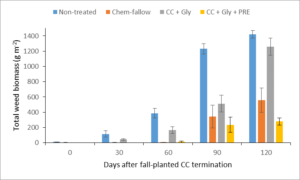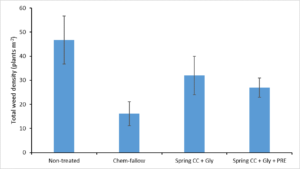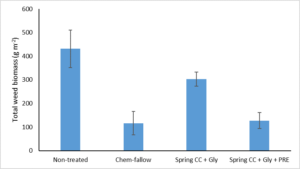Progress report for GNC22-346
Project Information
The widespread evolution of herbicide resistance in weeds poses a serious management challenge to growers in the semiarid Central Great Plains. Glyphosate-resistance has been widely reported in kochia (Bassia scoparia L.) and Palmer amaranth (Amaranthus palmeri L.) populations (two predominant weed species in the region). Furthermore, multiple herbicide resistance has also been reported in both weed species. Lack of cost-effective and alternative new herbicide sites of action (SOA) further exacerbate the problem of herbicide-resistant (HR) weeds and threaten the long-term sustainability of prevailing cropping systems in this region. Increasing herbicide costs to manage HR weeds has recently renewed research efforts to build a strong rationale for developing ecologically based integrated weed management (IWM) strategies in the region. Cover crops are known to suppress weed growth along with improvement in the soil health. However, there is currently limited information on the impact of cover crops grown in no-till (NT) dryland wheat-based crop rotation (wheat-sorghum-fallow) on the weed suppression, soil weed seedbank dynamics, soil water budget, crop yields and overall farm profitability. This proposed study will quantify the impact of fall vs. spring-planted cover crop management strategies on: 1) suppression of HR weeds (including kochia and Palmer amaranth), soil seedbank dynamics, and weed population shifts, 2) herbicide selection pressure (herbicide load) to mitigate/delay the resistance evolution, and 3) soil water budget and subsequent crop yields in NT dryland production system. This project aims to develop innovative, ecological-based, and economically sustainable weed management practices in the region, which will have long-term implications for reducing the over-reliance on herbicides and minimizing adverse environmental effects by implementing site-specific herbicide-resistance mitigation tactics.
This project will provide several learning and action outcomes mainly focused on profitability and quality of life. Regarding learning outcomes, growers will increase their profitability by effective management of HR weeds and save two to three herbicides application cost. Regarding action outcomes, utilizing cover crops for weed suppression will improve environment quality by reducing herbicides use for weed control. Indirectly, it will help in decreasing herbicide runoff into the environment, and it will reduce the selection pressure for further evolution of herbicide resistance in weed populations. The anticipated audience for this information is growers who can integrate cover crops in their cropping system for effective weed management. The growers in the western Kansas will be directly benefited; however, the data will be applicable to the growers throughout the CGP region. The outcomes will be measured by conducting a survey to see how likely growers who attend the field day demonstrations will implement these cover crop-based weed management practices on their production farms.
Research
A long-term field study at Kansas State University Agricultural Research Center near Hays, KS was established in Fall of 2022 under a no-till winter wheat-grain sorghum-fallow (WSF) crop rotation. A mixture of cover crops (CC) (winter triticale/winter peas/rapeseed/radish) was planted in fall in wheat stubble and terminated at triticale heading stage in the following spring. Similarly, a mixture of CC (spring oats/barley/spring peas) was planted in sorghum stubble in spring and terminated at oats heading stage. The study design was randomized complete block design with four replications. Fall both fall- and spring-planted CC, the treatments were: (1) weedy-fallow, (2) chemical-fallow, (3) CC terminated with glyphosate (GLY) alone, and (4) CC terminated with GLY + residual herbicide. In weedy fallow, no CC was planted and no herbicides were applied to control weeds. In chemical-fallow, no CC was planted but the plot area was treated with glyphosate at 1260 g ae ha-1 plus a premix of acetochlor/atrazine (ACR/ATZ) at 1665/826 g ai ha-1 or flumioxazin + pyroxasulfone (106/134 g ha-1) at the same time as CC termination. For CC termination, the GLY at 1260 g ae ha-1 was used and the residual herbicide was a premix of ACR/ATZ at 1665/826 g ai ha-1 or flumioxazin + pyroxasulfone (106/134 g ha-1). Data on total weed density and weed biomass were collected from each plot by using two 1-m2 quadrats prior to CC termination and then at monthly intervals after CC termination. Available soil water at cash crop planting was determined gravimetrically up to 1.5 m in 0.3 m depth increments in all plots. Wheat and grain sorghum yields were compared among all the treatments. All data were subjected to ANOVA using PROC MIXED procedure. Treatment means were separated using Fisher’s protected LSD test (P < 0.05).
No weed emergence was observed under fall-planted CC treatments at the time of termination. In addition, no weed emergence was observed in the fall-planted CC terminated with GLY plus ACR/ATZ treatment at 30 days after CC termination (DAT). Treatments, including the fall-planted CC terminated with GLY plus ACR/ATZ and chemical-fallow reduced the total weed density by 70% compared to weedy fallow at 90 DAT. Chemical-fallow and fall-planted CC terminated with GLY plus ACR/ATZ had significantly lower weed density (7 to 8 plants m-2) compared to weedy fallow (54 plants m-2 with 73% relative abundance of Palmer amaranth) at 120 DAT (Figure 1). Similar to weed density reduction, fall-planted CC terminated with GLY plus ACR/ATZ resulted in 98%, 46%, and 57% total weed dry biomass reduction compared to weedy fallow, chemical-fallow, and fall-planted CC terminated with GLY only, respectively at 60 DAT. At 120 DAT, the fall-planted CC terminated with GLY plus ACR/ATZ and chemical-fallow reduced the total weed dry biomass by 83% and 65% compared to weedy fallow (Figure 2). Fall-planted CC significantly reduced the volumetric water content at sorghum planting compared to chemical-fallow at 0-30 cm and 30-60 cm depths. No significant differences in the volumetric water content were observed between fall-planted CC and chemical-fallow treatments at deeper soil depths. No significant difference in grain sorghum yield was observed between chemical-fallow and fall-planted CC terminated with GLY plus ACR/ATZ. Spring-planted CC terminated with glyphosate + (flumioxazin + pyroxasulfone) reduced total weed density by 43% and total weed biomass by 71% compared to non-treated at 90 DAT (Figures 3 and 4).




Educational & Outreach Activities
Participation Summary:
The results from the study were presented at the field day at Agricultural Research Center, Hays, KS. Furthermore, several seminars were delivered on the study to the students at Kansas State University. The findings were also presented at the Annual Meeting of Weed Science Society of America.